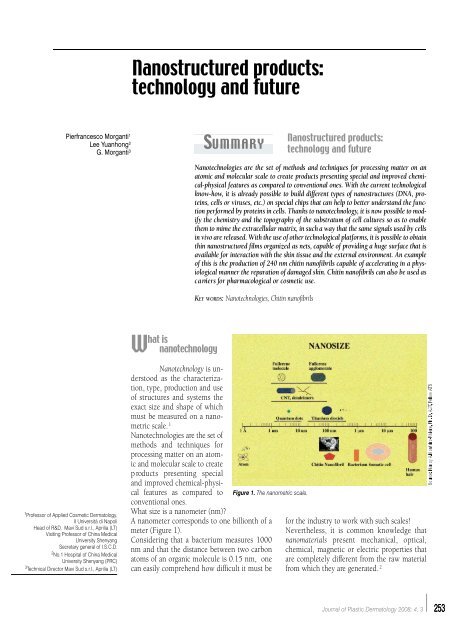N° 3 - Salute per tutti
N° 3 - Salute per tutti
N° 3 - Salute per tutti
Create successful ePaper yourself
Turn your PDF publications into a flip-book with our unique Google optimized e-Paper software.
Pierfrancesco Morganti 1<br />
Lee Yuanhong 2<br />
G. Morganti 3<br />
1 Professor of Applied Cosmetic Dermatology,<br />
II Università di Napoli<br />
Head of R&D, Mavi Sud s.r.l., Aprilia (LT)<br />
Visiting Professor of China Medical<br />
University Shenyang<br />
Secretary general of I.S.C.D.<br />
2 No.1 Hospital of China Medical<br />
University Shenyang (PRC)<br />
3 Technical Director Mavi Sud s.r.l., Aprilia (LT)<br />
Nanostructured products:<br />
technology and future<br />
hat is<br />
W nanotechnology<br />
SU M M A R Y<br />
Nanotechnology is understood<br />
as the characterization,<br />
type, production and use<br />
of structures and systems the<br />
exact size and shape of which<br />
must be measured on a nanometric<br />
scale. 1<br />
Nanotechnologies are the set of<br />
methods and techniques for<br />
processing matter on an atomic<br />
and molecular scale to create<br />
p roducts presenting special<br />
and improved chemical-physical<br />
features as compared to<br />
conventional ones.<br />
What size is a nanometer (nm)?<br />
A nanometer corresponds to one billionth of a<br />
meter (Figure 1).<br />
Considering that a bacterium measures 1000<br />
nm and that the distance between two carbon<br />
atoms of an organic molecule is 0.15 nm, one<br />
can easily comprehend how difficult it must be<br />
Figure 1. The nanometric scale.<br />
Nanostructured products:<br />
technology and future<br />
Nanotechnologies are the set of methods and techniques for processing matter on an<br />
atomic and molecular scale to create products presenting special and improved chemical-physical<br />
features as compared to conventional ones. With the current technological<br />
k n o w - h o w, it is already possible to build diff e rent types of nanostructures (DNA, proteins,<br />
cells or viruses, etc.) on special chips that can help to better understand the function<br />
<strong>per</strong>formed by proteins in cells. Thanks to nanotechnology, it is now possible to modify<br />
the chemistry and the topography of the substratum of cell cultures so as to enable<br />
them to mime the extracellular matrix, in such a way that the same signals used by cells<br />
in vivo are released. With the use of other technological platforms, it is possible to obtain<br />
thin nanostructured films organized as nets, capable of providing a huge surface that is<br />
available for interaction with the skin tissue and the external environment. An example<br />
of this is the production of 240 nm chitin nanofibrils capable of accelerating in a physiological<br />
manner the reparation of damaged skin. Chitin nanofibrils can also be used as<br />
c a rriers for pharmacological or cosmetic use.<br />
KE Y W O R D S: Nanotechnologies, Chitin nanofibrils<br />
for the industry to work with such scales!<br />
Nevertheless, it is common knowledge that<br />
n a n o m a t e r i a l s p resent mechanical, optical,<br />
chemical, magnetic or electric pro<strong>per</strong>ties that<br />
are completely different from the raw material<br />
from which they are generated. 2<br />
Journal of Plastic Dermatology 2008; 4, 3 253

















